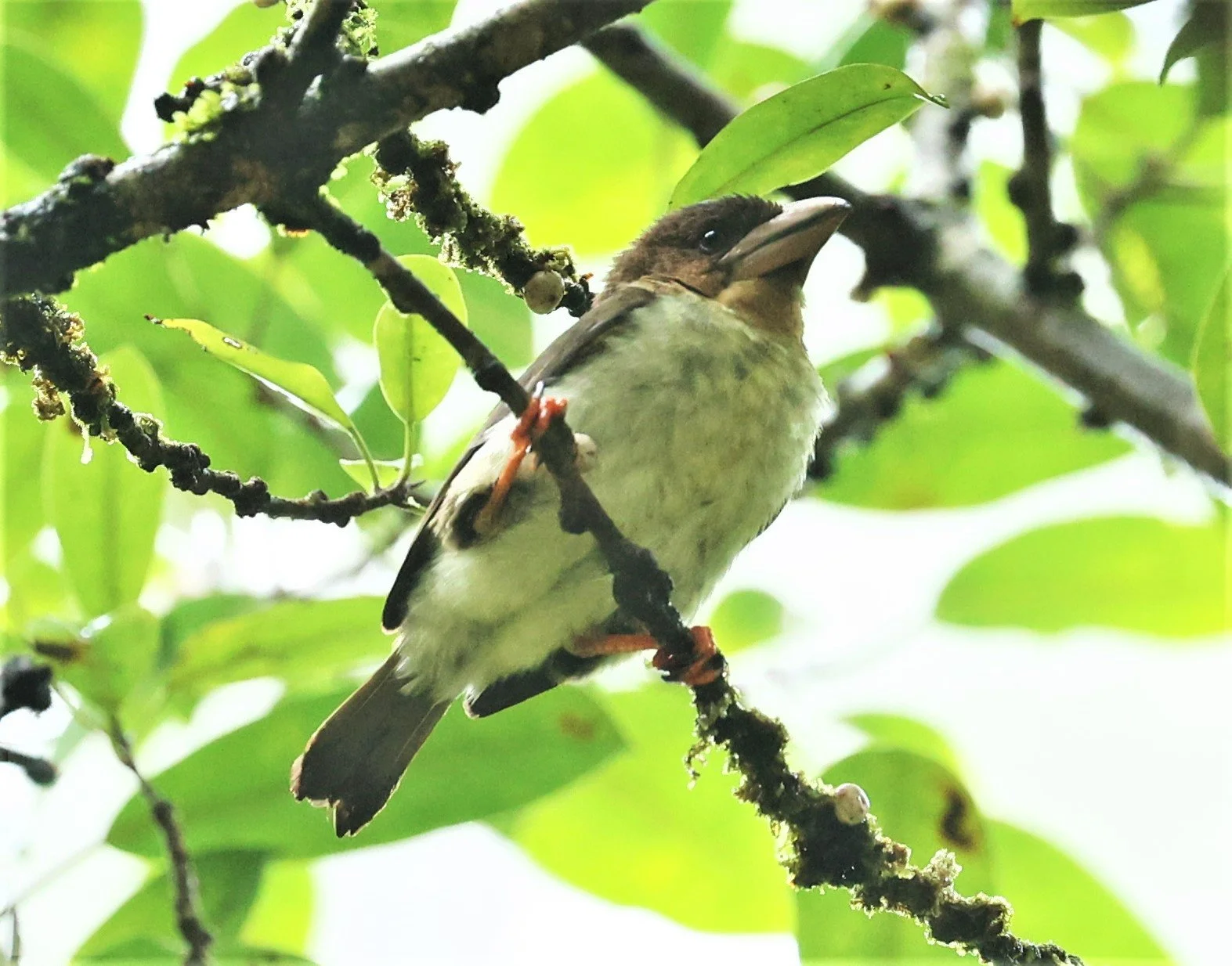
Family Megalaimidae & Family Lybiidae, the Asian & African Barbets

Fire-tufted Barbets are without a doubt my favorite species! This one was spotted on Fraser’s Hill, Malaysia
The Asian barbets are a family of bird species, the Megalaimidae, comprising two genera with 34 species native to the forests of the Indomalayan realm from Tibet to Indonesia. They were once clubbed with all barbets in the family Capitonidae but the Old World species have been found to be distinctive and are considered, along with the Lybiidae and Ramphastidae, as sister groups. In the past the species were placed in three genera, Caloramphus, Megalaima and Psilopogon, but studies show that Psilopogon to be nested within the clade of Megalaima. Since members of this clade are better treated under a single genus, they have been moved to the genus Psilopogon which was described and erected earlier than Megalaima and is therefore chosen on the basis of taxonomic priority principles. Nearly all members of the family are now in the genus Psilopogon, with the exception of those in Caloramphus, which are thought to have genetically diverged from the common ancestor around 21.32 million years ago. The latter species are distinct enough to warrant placement in a subfamily Caloramphinae. The family name is derived from that of the genus Megalaima which means ‘large throat’, from the Greek mega (μέγας, ‘large, great’) and laimos (λαιμός, ‘throat’).
The galleries that follow are of the various species of Asian Barbets that I have seen in South and Southeast Asia over the years. Some of these species are extremely showy and are sought after by twitchers and bird photographers alike. Considering how they tend to hang out in the dense foliage of the mid and upper canopy, they can be challenging to spot and photograph but are well worth the effort.
I have also seen several species of African Barbets and their galleries can be found linked below the Asian species.
Simply follow the links on the images below to visit the larger image galleries I have for each species.

Blue-eared Barbet (Psilopogon (Megalaima) australis) Thailand
Blue-throated Barbet (Psilopogon (Megalaima) asiatica) Thailand
Brown-headed Barbet (Psilopogon zeylanicus) Sri Lanka
Ceylon Small Barbet (Psilopogon (Megalaima) rubricapillus) Horton Plains, Sri Lanka (one image)
Coppersmith Barbet (Psilopogon (Megalaima) haemacephala) Thailand
Golden-throated Barbet (Psilopogon (franklinii) ramsayi) Phu Luang Wildlife Reserve Loei Province

Lineated Barbet (Psilopogon (Megalaima) lineata) Thailand
Great Barbet (Psilopogon virens) Thailand
Green-eared Barbet (Psilopogon (Megalaima) faiostricta) Thailand
Moustached Barbet (Psilopogon (Megalaima) incognita) Thailand
Red-crowned Barbet (Psilopogon (Megalaima) haemacephala) Thailand
Red-throated Barbet (Psilopogon mystacophanos) Southern Thailand
Fire-tufted Barbet (Psilopogon pyrolophus) Fraser’s Hill Malaysia
Sooty Barbet (Caloramphus hayii) Southern Thailand & Malaysia

The African barbets are birds in the family Lybiidae. There are 43 species ranging from the type genus Lybius of forest interior to the tinkerbirds (Pogoniulus) of forest and scrubland. They are found throughout sub-Saharan Africa, with the exception of the far south-west of South Africa.
Red & Yellow Barbets of East Africa are my favorite species
The African terrestrial barbets, Trachyphoninae, range from the southern Sahara to South Africa. Members of one genus, Trachyphonus, are the most open-country species of barbets. The subfamily Lybiinae contains the African arboreal barbets. There are 37 species of Lybiinae in 6 genera.
Most African barbets are about 20–25 cm (7.9–9.8 in) long, plump-looking, with large heads, and their heavy bill is fringed with bristles; the tinkerbirds are smaller, ranging down to the red-rumped tinkerbird (Pogoniulus atroflavus) at 7 g (0.25 oz) and 9 cm (3.5 in).
They are mainly solitary birds, eating insects and fruit. Figs and numerous other species of fruiting tree and bush are visited. An individual barbet may feed on as many as 60 different species in its range. They will also visit plantations and take cultivated fruit and vegetables. Fruit is eaten whole and indigestible material such as seed pits regurgitated later (often before singing). Regurgitation does not usually happen in the nest (as happens with toucans), although tinkerbirds do place sticky mistletoe seeds around the entrances of their nests, possibly to deter predators. Like other barbets, they are thought to be important agents in seed dispersal in tropical forests.
As well as taking fruit, African barbets also take arthropod prey, gleaned from the branches and trunks of trees. A wide range of insects are taken, including ants, cicadas, dragonflies, crickets, locusts, beetles, moths and mantids. Scorpions and centipedes are also taken, and a few species will take small vertebrates such as lizards, frogs and geckos.
The precise nesting details of many African barbets are not yet known, although peculiarly among the Piciformes, some sociable species will nest in riverbanks or termite nests. Like many members of their order, Piciformes, their nests are in holes bored into a tree, and they usually lay between 2 and 4 eggs (except for the yellow-breasted barbet which lays up to 6), incubated for 13–15 days. Nesting duties are shared by both parents.
There has been generally little interference by humans. Some of the species which require primary woodland are declining due to deforestation, occasionally to the benefit of close relatives. For example, the loss of highland woods in Kenya has seen the moustached tinkerbird almost disappear and the red-fronted tinkerbird expand its range.

Acacia Pied Barbet (Tricholaema leucomelas) Etosha, Namibia
Black-billed Barbet (Lybius guifsobalito) Awash, Ethiopia
White-headed Barbet (Lybius leucocephalus) Kenya
Black-collared Barbet (Lybius torquatus) Saint Lucia, South Africa
Crested Barbet (Trachyphonus vaillantii) South Africa
Red-and-Yellow Barbet (Trachyphonus erythrocephalus) Samburu, Kenya

Usambiro Barbet (Trachyphonus usambiro) Kenya
D’Arnaud’s Barbet (Trachyphonus darnaudii) Samburu, Kenya
Double-toothed Barbet (Pogonornis bidentatus) Langano Lake Ethiopia
Red-fronted Tinkerbird (Pogoniulus pusillus) Saint Lucia, South Africa (One image only)

























